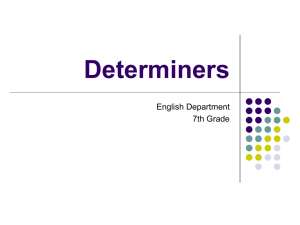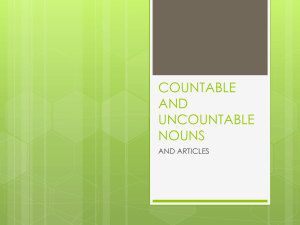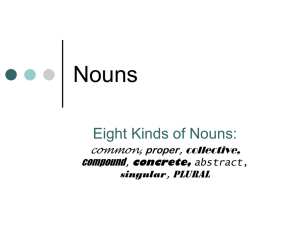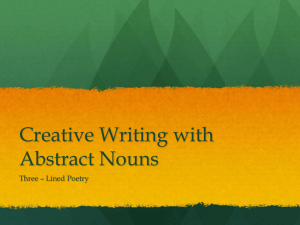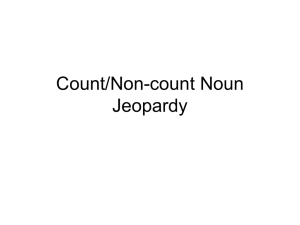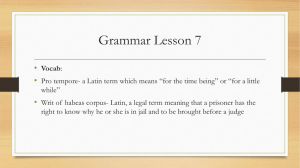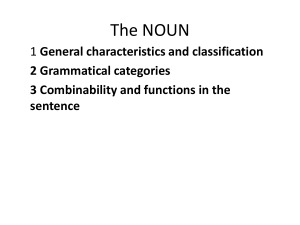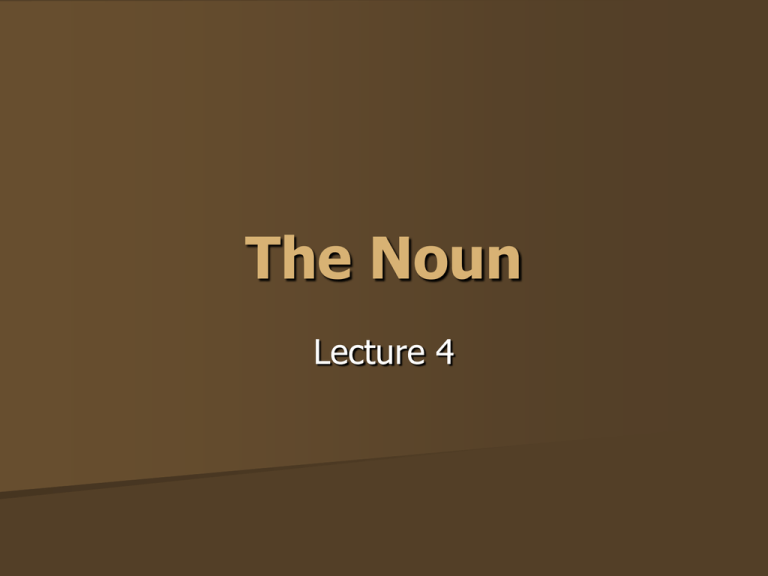
The Noun
Lecture 4
The noun is a class of words denoting
entity (a separate unit that is complete and
has its own characteristics).
The noun is the central nominative word
class.
A typical noun has sense
the inherent
meaning of the noun.
Ex. the sense of girl
'young female
human being'
Nouns are commonly thought of as
"naming" words, and specifically as the
names of "people, places, or things".
Nouns such as John, London, and computer
certainly fit this description, but the class of
nouns is much broader than this.
Nouns also denote abstract and intangible
concepts such as birth, happiness, evolution,
technology, management, imagination, revenge,
politics, hope, cookery, sport, literacy....
Because of this enormous diversity of
reference, it is not very useful to study
nouns solely in terms of their meaning.
It is much more fruitful to consider them
from the point of view of their formal
characteristics.
Characteristics of Nouns
Semantic
Syntactic
Morphological
characteristics characteristics
characteristics
of a noun
of a noun
of a noun
Denotes
Functions as
Inflected for
concrete entity head of NP (e.g. number (plural)
(e.g. dog) or
the girl); can in
and case
abstract notion
some cases
(genitive)
(e.g. idea)
function as a
premodifier in a
NP (e.g. an oak
table)
The noun class can be subdivided into the
following semantic subclasses:
Noun
Proper
(Tom)
Common
Uncountable
Countable
Abstract
Concrete Abstract Concrete
(hate)
(thought)
Collective Mass
Collective Individual
proper
(milk)
improper
(crew)
Animate
Inanimate
Animate
Inanimate
(vermin)
(furniture)
(toy)
Personal Non-personal
(child) (dog)
Common and Proper Nouns
The basic division of the noun class is into
common nouns and PROPER NOUNS.
Nouns which name specific people or
places are known as proper nouns.
They are used to denote individuals,
places, oceans, institutions, etc.
For example, John, Mary, London, France.
Since proper nouns usually refer to
something or someone unique, they do
not normally take plurals.
However, they may do so, especially when
number is being specifically referred to:
There are three Davids in my class.
We met two Christmases ago.
For the same reason, names of people and
places are not normally preceded by
determiners the or a/an
though they can be in certain circumstances:
It's nothing like the America.
Remember my brother is an Einstein at maths.
Changes in the meaning of the noun
along the scale proper → common
+ proper
+/- animate
+/- human
+/- female
+/- countable
+ concrete
+ common
- sex (neuter)
+ countable
+ concrete
Common Nouns
Common nouns denote classes of similar
referents or specific representatives of
certain classes:
The computer is widely used nowadays.
The computer is on the desk.
common nouns
countable nouns & uncountable nouns
Some can be either count or non-count,
depending on the kind of reference they have.
Ex. I made a cake, cake is a count noun,
singular number.
However, in I like cake, the reference is less
specific. It refers to "cake in general", and so
cake is non-count in this sentence.
Count and Non-count Nouns
Common nouns are either count or noncount.
count nouns can be "counted", as
follows: one pen, two pens, three pens, four
pens...
non-count nouns cannot be counted in this
way: one software, *two softwares, *three
softwares, *four softwares...
non-count nouns do not take a/an
Count
Non-count
a pen
*a software
Countable nouns have two categorical forms of
number – singular and plural.
Uncountable nouns have only one form – either
singular or plural.
Both countable and uncountable
nouns fall into two semantic varieties –
concrete and abstract.
Concrete nouns denote material referents.
Abstract - immaterial referents.
individual nouns
Countable concrete nouns
collective nouns
improper
animate (beings)
Individual nouns
-
material entities
inanimate (objects)
personal (human beings)
Animate nouns
non-personal (other species)
singular form
Individual nouns
plural form
Collective nouns improper are treated
grammatically as countable nouns
The class is in the room.
The classes are in the room.
Plurality can also be marked by a plural
pronoun:
The senior class, who had a meeting,
decided they would have a party.
Uncountable concrete nouns
mass nouns
collective nouns proper
Mass nouns denote substances
Example: Honey is good for you.
Animate collective nouns proper + plural
word forms:
Vermin were crawling all over the place.
Inanimate collective nouns proper are
treated as singular: Fruit is good for you.
Uncountable abstract nouns are in the
singular: Hate is a negative feeling.
the semantic and formal feature
undergoing change → types of shift:
Proper noun → Common noun
Common noun → Proper noun
Countable noun → Uncountable noun
Uncountable noun → Countable noun
Abstract noun → Concrete noun
Concrete noun → Abstract noun
Shifts are discussed by M. Mincoff in
his ‘English Grammar’ (1958)
various transformations are leading to the
shift
these shifts will be discussed in pairs
Proper noun → Common noun
Proper nouns have unique referents
No plural
No article
Certain types of semantic change →
the noun in the plural or with some
grammatical determiner
the + personal name
a. The + name + relative clause:
I recognized Brian, the Brian who had been at
school with me.
b. The + a famous name:
‘The man’s name was Alfred Hitchcock. Not the
Alfred Hitchcock.’
the + personal name plural
Ex: She has been lunching with the Wilsons for
nearly three months. (=the members of the
family of Wilson)
Ex: Two Janes work in this office. < Two Janes
work in this office.
a + personal name singular
one of the members of a family:
Remember you are an Osborn – it’s a name to be
proud of.
a/an + the name of a famous person
else with similar abilities, appearance,
character:
Already he is being hailed as a young Albert
Einstein.
s.o.
a + personal name singular
the speaker doesn’t know anything about the
referent of the name:
There is a Mr. Alex Murrey asking to see you.
‘There is a man called Mr. Alex Murrey.’
a/an + the name of a famous artist or writer
instead of a picture or a book of that person:
The gallery has recently acquired a Picasso.
another + proper noun
someone or something with similar
qualities:
Music fans are already calling him another Frank
Sinatra.
There were fears that the war is Bosnia might
become another Vietnam.
the + numeral + geographic name
Parallel geographical names exist.
Such names can be used in the plural and
also defined by the definite article:
the two Americas
Common noun → Proper noun
Many proper nouns have originated from
common nouns:
a daisy → Daisy;
brown → Brown;
a bush → Bush
Such nouns are included in dictionaries as
separate lexemes.
Countable noun → Uncountable noun
The shift from countable to uncountable is
often accompanied by a shift from individual to
generalized or from concrete to abstract
(no article):
Her husband has been sent to prison for three
years. (The speaker is referring to the institution
in general.)
We went by plane. (The speaker is talking
The kids are still at school. (The speaker is
about a form of transport.)
referring to the period of one’s life when one
goes to school.)
Uncountable noun → Countable noun
Uncountable nouns do not form a plural.
They do not take the indefinite article.
However, in certain contexts, uncountable
nouns acquire semantic connotations
converting them into countable nouns.
The semantic shifts of uncountable concrete
mass nouns to countable nouns involve shifts
from generalized to individualized
meanings.
An uncountable concrete mass
noun → a countable noun (a
particular kind of substance):
Cheese is a solid food made from milk.
(generalized)
This shop sells a range of French cheeses.
(individualized)
He was lying full length on the grass.
(a common plant)
I could see various tall flowering grasses.
(particular types)
A mass noun → a countable noun (a
portion - individualized quantity):
Ice cream is frozen sweet food.
Would you like an ice cream?
(one portion)
A mass word can be used by
metonymy to refer to an object
made from the substance:
Nickel is a hard silver metal.
A nickel is a coin worth five cents.
She likes cake. (a sweet food)
She was making a cake for his birthday.
(a particular product)
Uncountable abstract nouns
countable nouns, undergoing a parallel
shift from abstract to concrete:
Beauty is the quality of being very good to look at.
(the quality)
She is a beauty. (a beautiful woman)
I like cars and this one is a beauty.
(an object characterized by the quality)
The beauty of working at home is that you don’t
have to travel. (advantage)
Sometimes the use of the shifted noun is
metaphorical.
The neighbours said that we were making
too much noise.
(literal use)
She makes all the right noises about
economic reform.
(metaphorical use)
Not all uncountable nouns can undergo
such semantic shifts.
There are other means of individualization
and concretization of meaning.
One of them is the partitive phrase.
Concrete nouns:
a blade of grass
a piece of cheese
a bottle of rum
a bar of chocolate
a glass of milk
a cake of soap
a mug of coffee
a packet of biscuits
Abstract nouns:
a piece of music
a bit of consolation
a word of praise
an item of news
a stroke of good luck
an act of revenge
an article of news
a hint of advice
Sometimes individualization is achieved
through pairs of nouns
the uncountable noun in the pair
denotes the substance
the countable noun denotes the
article made from that substance:
wood → tree; bread → loaf

